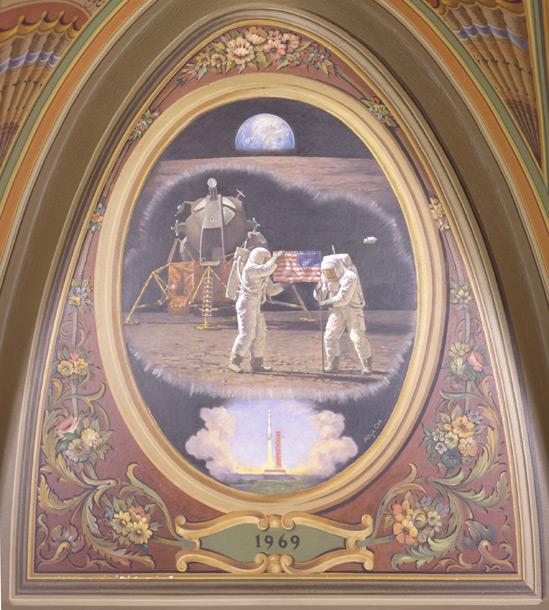
| Title | America's First Moon Landing, July 21, 1969 |
| Artist/Maker | Allyn Cox ( 1896 - 1982 ) |
| Date | 1975 |
| Medium | Oil on canvas |
| Dimensions | h. 34 x w. 18 in. (h. 86.4 x w. 45.7 cm) |
| Credit Line | U.S. Senate Collection |
| Accession Number | 35.00001.000 |
This oval mural commemorating America’s moon landing embellishes the Brumidi Corridors in the Senate wing of the Capitol. The mural’s three main elements are: the rocket that propelled the astronauts into orbit; astronauts Neil Armstrong and Buzz Aldrin planting the United States flag on the moon, with the lunar module Eagle in the background and the space capsule Columbia circling the moon; and a view of Earth as seen from the moon. Although the Eagle landed on the moon in the afternoon of July 20, Armstrong and Aldrin did not erect the flag until the next morning, which explains why the scene is dated July 21, 1969.
Muralist Allyn Cox painted the work. The son of artists Kenyon and Louise King Cox, Allyn Cox was born in New York City. He was educated at the National Academy of Design and the Art Students League in New York, and the American Academy in Rome. Cox began receiving commissions for murals after his return from Italy in 1920. His earliest public works are in the collections of the William A. Clark Library in Los Angeles and the University of Virginia Law School in Charlottesville.
In 1972 the U.S. Senate Commission on Art directed that a mural commemorating the moon landing be commissioned and placed in the Capitol’s Brumidi Corridors, which were originally decorated between 1857 and 1878 by Italian-born fresco painter Constantino Brumidi, who left several areas unfinished. In 1974 Cox prepared and submitted his design for America’s First Moon Landing, July 21, 1969. He received advice and assistance on artistic and technical decisions from museum professionals at the National Aeronautics and Space Administration (NASA), the Smithsonian Institution’s National Air and Space Museum and National Portrait Gallery, and the U.S. Capitol. Cox executed the final work on canvas in his studio and in April 1975 the mural was completed and installed.
Earlier, in 1952, Cox rendered scenes to fill out the last three panels of the panoramic frieze in the Capitol Rotunda. From 1973 until his retirement in 1982, Cox painted the ceilings of the Capitol’s first floor House corridors with scenes depicting the development of Congress and the growth of the nation. This work was completed by his assistant, Clifford Young. In remarks in the Congressional Record that year, Cox was hailed as “the American Michelangelo” for his Capitol murals. [1] The artist is also represented in the U.S. Senate by a portrait of Henry Clay in the Senate Reception Room.
1. Congressional Record (28 September 1982) vol. 128, pt. 125: 12436.